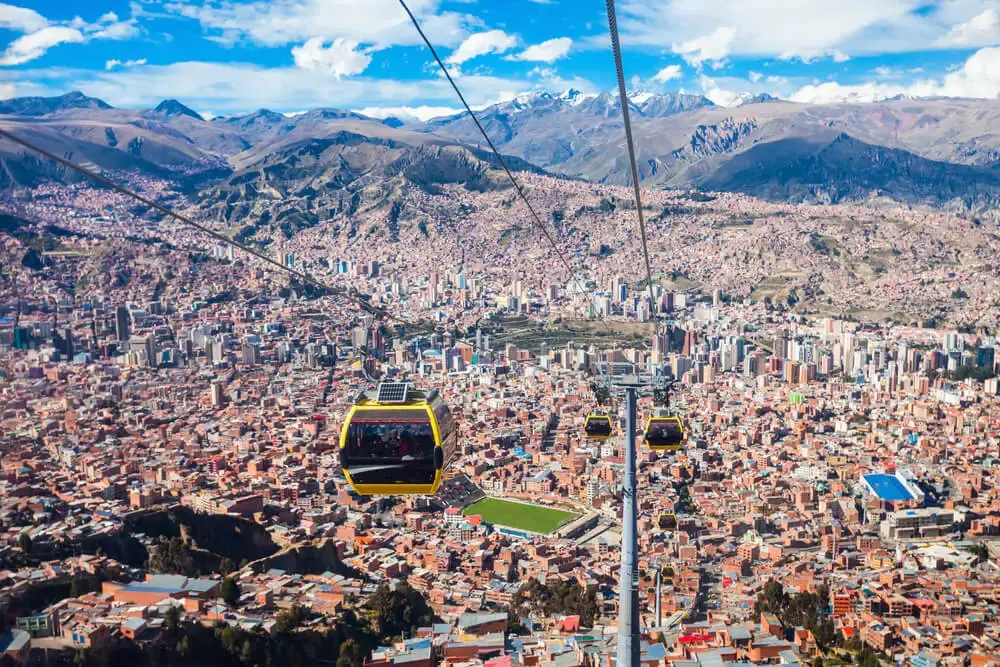Credit: saiko3p / Shutterstock.com

Anyone who has ever spent a winter holiday in the mountains has more than likely come across the name Doppelmayr. With a market share of 60%, the former cable car construction pioneers not only lead the industry in numbers, but the Doppelmayr/Garaventa Group is also considered a spearhead of innovation within the industry, introducing new, faster, and more comfortable lifts, as well as delivering cable car technology for adventure parks, suspension railways in Las Vegas, and transportation to attractions such as the Great Wall of China. In addition, it is establishing itself in the field of alternative urban transportation, especially in Asia and South America. How did Doppelmayr find its way to the top?
When Konrad Doppelmayr took over his employer’s farrier business in Wolfurt, Austria, in 1893, he initially focused on manufacturing tools and repairing machines. After World War I, skiing turned into a sport for the masses and mountain slopes needed to be developed. Konrad Doppelmayr’s successor Emil was one of the first to discover the market niche. In 1937, he built Austria’s first ski lift in Zürs. After World War II, he quickly put out feelers in the international market, and in 1953, he delivered the company’s first lift to Canada. Over the years, Doppelmayr lifts and cable cars have become a staple of transportation in 40 different countries.
After merging with Swiss competitor Garaventa, the newly established group continues to thrive. With 60% market share and branches or representatives in 50 countries, Doppelmayr/Garaventa is at the forefront of the industry. Its solutions are also popular in the huge Chinese market – both in newly emerging winter sports areas and in summer tourism. For example, a gondola lift near Beijing transports up to 2,400 passengers an hour to the Great Wall of China, and China’s first large orbital ropeway (“tri-cable gondola”) was built in the world-famous Lushan National Park in 2017.
What are the pillars of Doppelmayr’s success? And what can other companies learn from it?
Moving early: Recognize and develop potential markets
Developing mountain slopes for winter sports and tourism was a completely new – and economically risky – undertaking in the late 1930s. Together with former ski jumper and skiing pioneer, Sepp Bildstein, Emil Doppelmayr nevertheless ventured to build the first lift in Austria. This enabled Doppelmayr to establish itself early on as a specialist in a promising niche.
Even today, Doppelmayr/Garaventa keeps a keen eye on new market potential. This includes, among other things, urban passenger transportation. In 2019, the world’s largest urban cable car network was completed in La Paz, Bolivia, consisting of 10 lines and covering a total distance of more than 20 miles. The group has its eyes set in particular on the cities of Asia and South America with their underdeveloped traffic systems. For example, the group was recently commissioned by Mexico City to build another city cable car based on the model of La Paz.
Diversification: New ideas for existing clients
Ideally, high-quality cable car facilities can be in use for decades, and the amount of new winter sports areas is increasingly limited. That is why Doppelmayr/Garaventa encourages existing customers to make further investments and upgrades by regularly introducing innovations. Cogwheel railways, chair lifts with heated seats and Ferris-wheel-like gondola feeders are designed to facilitate the ride and turn a gondola journey into an experience, spurring competition between the winter sports areas and thus also demand. In addition, Doppelmayr/Garaventa attracts attention with unusual custom-made products: for example, a gondola equipped with eight individual whirlpools for a Japanese customer caused a stir not only in the industry but also in the general press.
Digitalization: Leading the way with „Smart Ropeway“
The cable car industry is also subject to increasing digitalization. Doppelmayr/Garaventa meets the challenge with their “Smart Ropeway” concept, which aims to design the operation and maintenance of systems efficiently and safely. For instance, two autonomous cable cars have already been installed in France. But gondolas and funicular railways are also bound to become smarter. A core area of ”Smart Ropeway” is focusing on the customer experience while onboard, turning the gondola into an infotainment center for passengers. This includes calling up information and weather data as well as charging stations for smartphones or the option to play personal playlists via an app.
Innovation: from Las Vegas to Hogwarts
Especially in these times of increasing climate change, market alternatives to winter sports are gaining in importance. The main focus of Doppelmayr/Garaventa is on the future of the adventure tourism market, utilizing its technology perfected in the alpine area in various ways. The Mandalay Bay Tram, for example, has been running in Las Vegas since 1999. The Hogwarts Express at the Universal Orlando Resort whisks visitors through the Harry Potter adventure world within four minutes using Doppelmayr/Garaventa cable car technology. The group is also involved in the expansion of Luton Airport in London. From 2021, an automated cable liner is to connect the international airport with central London in just about 30 minutes. Doppelmayr/Garaventa seems to have positioned itself well in the future of urban transport.
Doppelmayr: MARMIND® Top Tips
Quality first – a good product is the best marketing strategy, especially when it comes to B2B.
Diversify proven technology to enter new markets in a sensible way.
Keep moving – improving your product in innovative ways keeps your customers close.
This article is based on the following sources:
https://www.zeit.de/2015/21/michael-doppelmayr-lifte
http://newsroom.doppelmayr.com/en/
https://de.wikipedia.org/wiki/Doppelmayr/Garaventa-Gruppe
https://www.diepresse.com/5496309/doppelmayr-die-seilbahn-erobert-die-grossstadt

